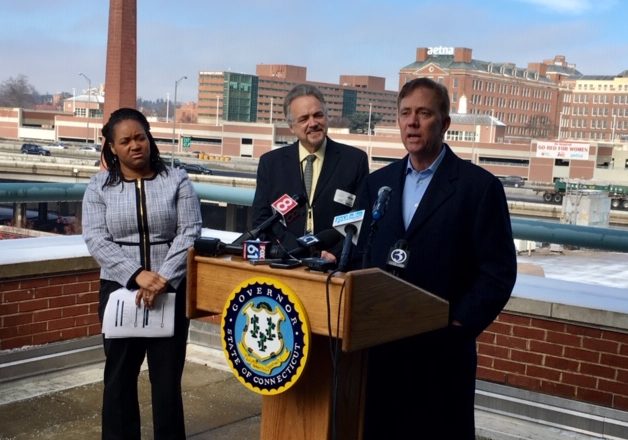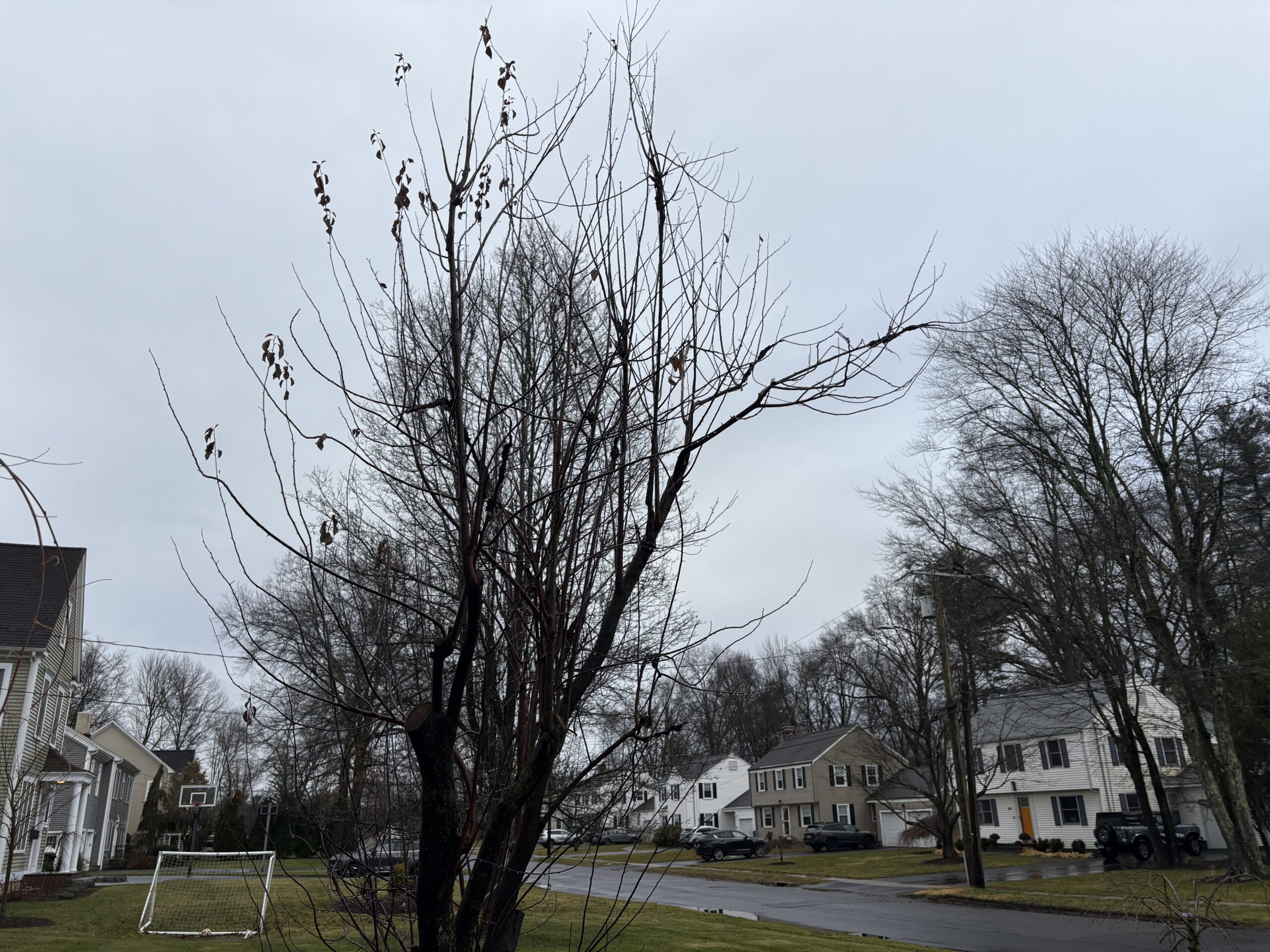Lamont’s Campaign for Tolls Begins a Critical Phase

Audio By Carbonatix

Gov. Ned Lamont by the I-84 viaduct in Hartford flanked by budget chief Melissa McCaw and Transportation Commissioner Joseph Giulietti. Photo credit: Mark Pazniokas, CTMirror.org
Marc Bradley, who ran the governor’s winning campaign in 2018 and now oversees external and constituent services, and former West Hartford State Sen. Jonathan Harris, now an undersecretary at the Office of Policy and Management, are among those leading the governor’s lobbying efforts for tolls.
By Mark Pazniokas, CTMirror.org
Gov. Ned Lamont’s push for highway tolls has entered a new and critical phase: The administration rebooted its lobbying team two weeks ago, and they are talking to legislators about a series of tweaks intended to increase the consumer and political appeal of the governor’s top priority and biggest challenge.
With less than six weeks until the legislature’s constitutional adjournment deadline, the administration and lawmakers are trying to settle on a legislative draft specific enough to assure them of what they are buying, but flexible enough to enable Lamont to negotiate a final tolls plan with the Federal Highway Administration.
A small reduction in the gasoline tax, cheaper inner-city bus fares, ways to provide discounts for drivers who lack the credit or checking accounts necessary for an EZ pass, a list of specific transportation improvements, and limits on pricing and the number of tolling gantries are among the items sources say are under discussion.
“This opportunity to truly transform the transportation system and therefore Connecticut’s economy for decades to come doesn’t come along every year, and we don’t intend to waste that opportunity,” said Colleen Flanagan Johnson, the governor’s senior adviser who is now overseeing a staff of a half-dozen aides working on the tolls campaign.
House and Senate Democratic legislative leaders say they welcome a new lobbying effort that includes two administration officials: Marc Bradley, who ran the governor’s winning campaign in 2018 and now oversees external and constituent services; and former state Sen. Jonathan Harris, an undersecretary at the Office of Policy and Management.
“I think they’re bringing in people who have a good relationship with the legislature,” said Senate President Pro Tem Martin M. Looney, D-New Haven. “Jonathan, having served in the Senate, is very well regarded in this chamber, and Marc Bradley is someone enormously well-respected for the role he played in the campaign.”
Legislators generally panned the administration’s roll out of the tolls proposal in February, complaining it lacked details about how it would work or a strategy for passage. The administration’s pitch has been the state needs tolling revenue to maintain and modernize infrastructure, while offering few specific ideas that would spark the imagination about faster commutes worth the price of tolls.
Looney and House Speaker Joe Aresimowicz, D-Berlin, were among a small group of Democratic lawmakers to meet Wednesday with Lamont and his transportation commissioner, Joseph J.Giulietti, about the still-evolving tolling legislation and what it could mean for Connecticut commuters.
“As long as we’re having this open dialogue, I think we can get there,” Aresimowicz said of getting tolls to a vote. “I can’t say if it’s going to be three weeks from now or if it’s going to be on the last night. But I’m feeling more confident we can get to a deal that allows us to fund our infrastructure.”
Two weeks ago, Lamont and the Democratic co-chairs of the legislature’s Transportation Committee tried to reframe the issue in terms of specific rush-hour commutes, assuming 4.4 cents a mile with discounts for state drivers: from New Haven to Hartford on 91, $1.72; from Stamford to New Haven on 95, $1.80; from Danbury to Waterbury on 84, $1.28.
Lamont said last week he saw no need for more details about his plan: He already had spelled out there would be no more than 50 tolling gantries on the state’s four most-congested highways, Route 15 and Interstates 84, 91 and 95. But his staff already was at work with lawmakers to add details to a tolls bill.
Flanagan Johnson declined to confirm whether a gas-tax reduction would be an element of a tolls deal, but she acknowledged an emphasis on trying to mitigate the impact of tolls on lower-income commuters. The administration was looking at discounts for those who most need them, as well as the mechanics of how to provide EZ passes to drivers without credit or bank accounts.
“The discounts are a major issue for my caucus,” Aresimowicz said.
An issue that has proven harder to resolve are the limits a bill would place on pricing. How much flexibility would the legislature entrust the state Department of Transportation?
Connecticut is being permitted to devise a tolling system without losing federal highway revenue under a specific program that calls for peak and off-peak prices to discourage driving at peak times. A challenge for state officials is the lack of guidance from the Federal Highway Administration on the pricing differential desired for peak and off-peak trips.
“There is no hard and fast number,” said Thomas J. Maziarz, the state DOT’s chief of policy and planning.
The state will try to make the case that data shows even a modest difference in pricing will result in less traffic, and that revenue from the tolls will permit projects that could make significant improvements, especially on the often gridlocked stretch of I-95 in Fairfield County. One potential project would be expanding the exit lanes from I-95 onto Route 8 in Bridgeport, a major bottleneck in the afternoon commute north from Stamford, he said.
The administration is working on a vote count, a task complicated by the lack of a finished piece of legislation.
Sen. Gary Winfield, D-New Haven, said he is a strong supporter of tolls in concept, but needs more details.
“What are you asking us to do?” said Rep. Jeffrey A. Currey, D-East Hartford.
Flanagan Johnson said her staff knows the questions, and the bill must provide answers.
“What do the rates look like? What kind of certainty can we give, not only to residents but to legislators who are taking this vote? There will be some more structure around that. What we want to make sure we do is provide information to legislators who are taking the vote to help them fully understand the opportunity they have to make a true difference in Connecticut’s economy.”
The give-and-take with legislators is constructive, she said, with lawmakers learning more about the process and the administration seeing the issues that must be resolved before commitments are made. That process takes time.
“People want to know what the bill is before they say hard yes, hard no. And that’s more than fair,” Flanagan Johnson said. “So we’re working through that. On the other end, we don’t want to rush it to simply get a bill. We want to get the right bill.”
In separate interviews, Looney and Aresimowicz said the first vote by the House or Senate on tolls must come no later than June 3. The session ends two days later.
Reprinted with permission of The Connecticut Mirror. The author can be reached at [email protected].
Like what you see here? Click here to subscribe to We-Ha’s newsletter so you’ll always be in the know about what’s happening in West Hartford!



